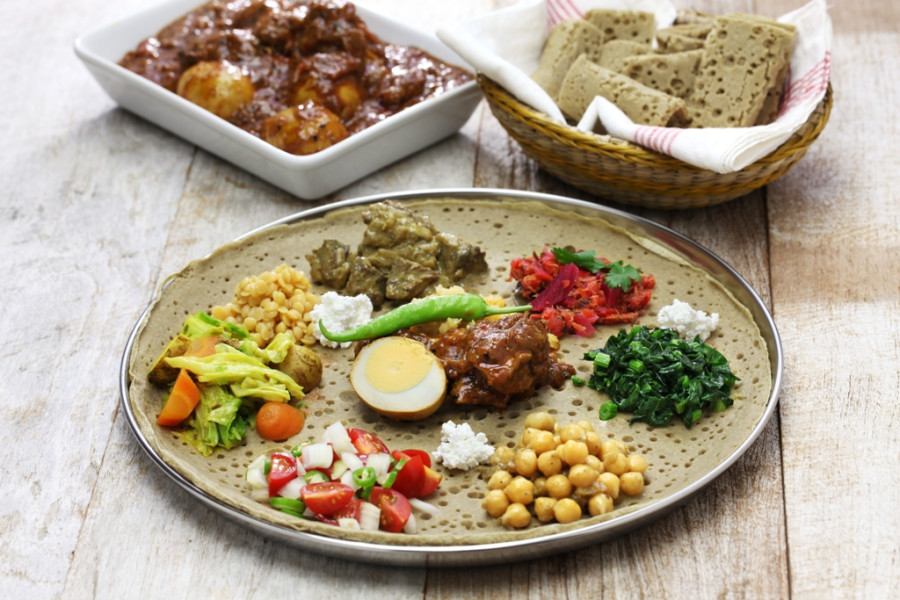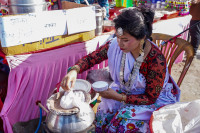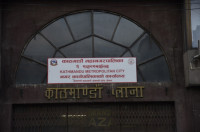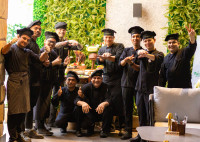Food
Ethiopian pop-up restaurant comes to Nepal
For the average Nepali, doro wat, gomen and berbere might sound alien, but one taste of these Ethiopian delicacies and Nepalis might just recognise the flavours.
Thomas Heaton
For the average Nepali, doro wat, gomen and berbere might sound alien, but one taste of these Ethiopian delicacies and Nepalis might just recognise the flavours. Among a host of other herbs and spices, there is a lot of chilli, ginger, cumin and coriander—all familiar to the Nepali palate. But there is much more to Ethiopian food and now, Kathmandu residents can taste it for themselves.
First started in Kathmandu at the Le Sherpa Farmers’ Market in November, Addis, Kathmandu’s first Ethiopian eatery, is a pop-up restaurant that runs in different spots throughout the week and across the city. Found on Saturdays in Lazimpat, at Le Sherpa in the morning and Oshell FoodBar in the evening, Addis will be coming to Top of the World Coffee in Jhamsikhel this Friday.
Nepali and Ethiopian plates share similarities, given that they are both eaten with hands and both cuisines are heavily spiced and comprise small dishes of vegetables and meat. Like Nepal, Ethiopia likes lentils, has long-braised stews, uses clarified butter, eat-with-your-hands bread and similar spices. Chilli, ginger, garlic, coriander, rue and various dried herbs are mainstays in the cuisine, and constitute a typical berbere spice mix.
Manager Betty Attfield brings in a few unavailable ingredients from Ethiopia, including the berbere mix, but the majority are easy to find. This considered, they are still very different cuisines, says Attfield says.
“It’s quite subtle, but there are big differences. Ethiopian cuisine is based a lot on onions. To get that really nice taste, it’s all slow-cooked. We also use a hefty amount of chillies and spices. But it’s not ‘hot’, as in it’s cooked quite quickly,” she says. “And while our lentils might look like dal, they are cooked over an extremely long time.”
Even the clarified butter is different, with spices added to it. It is stirred into dishes to finish them.
Over coming weeks, the pop-up will diversify its menu with a few new dishes, such as tibs, a sizzling mutton dish; ful, a smashed bean dish; kitfo, a ground meat dish seasoned with clarified butter and spices; and chicken samosas. But for now, here is the standard Ethiopian plate that unfamiliar Nepalis can expect from Addis, as told by Attfield:
Injera
Photo by Thomas Heaton
A typical ethiopian meal comprises of dollops of different stews and vegetable dishes atop injera, a typical sourdough flatbread made with a native grain called teff.
Quite literally the base of Ethiopian food, injera is a sour crepe-like carbohydrate that is eaten across the country. The endemic species of grain used in this bread is made into a flour before being added to water and fermented over the course of a day. Later mixed with other flours to form a dough, the bread is cooked on a special skillet and used to scoop and grab the dishes that top it.
“We bring the teff from Ethiopia. Unfortunately we’re not allowed to take it out in large amounts, so we mix it with millet and rice or corn flour,” says Attfield.
In Ethiopia, the teff is traditionally blended with other locally-grown grains, because it is difficult to cultivate in large quantities. Naturally gluten-free, the grain is considered a ‘superfood’ because of its high iron, fibre and calcium content.
When cooked, the dough becomes spongy. Sour bread might sound odd, and it can be a bit of an acquired taste for Nepalis.
“It is sour but when you eat it with the different stews, it blends very well,” Attfield says.
Doro wat
Photo by Thomas Heaton
Doro wat is a delicacy usually reserved for special occasions. A hearty mix of chicken and boiled eggs, it is Ethiopia’s national dish. Traditionally, women were not considered ready for marriage until they had mastered the doro wat.
“If you have guests in your house or you’re celebrating, you have to have doro wat,” says Attfield.
It might look like a curry but it’s actually a stew. Using berbere spices as the base, doro wat is spicy and hearty, finished with typical Ethiopian spiced clarified butter.
There is also sega wat, which is traditionally made with either beef or mutton. Addis in Kathmandu usually opts to make this dish a little less spicy to cater to everyone’s spice tolerances, and serves it with homemade ayib, cottage cheese, for balance. It is filled with turmeric and onions, and fried at the end. Then, the kibe, spiced clarified butter, is added.
“It’s not really like a stew. It’s a bit drier,” says Attfield.
Misir wat

Photo courtesy: Shutterstock.com
While lentils are extremely popular across Nepal, Ethiopia’s spiced red lentils are quite different. While the colour might stand out as a major difference, the thicker texture and level of spice are pronounced. Cooked with tomatoes, onions, garlic, clarified butter and the ever-versatile berbere spice blend, the lentils mostly hold their shape in this rich dish. Ethiopia has a plethora of vegetarian and vegan dishes that cater to periods of fasting throughout the year. Wednesdays and Fridays, in addition to six weeks of lent, are traditionally days of fasting in the Ethiopian Orthodox Church, when people abstain from eating meat products, dairy and eggs.
“That’s basically 200 days a year, so we have lots of vegan foods,” says Attfield.
Gomen

Photo courtesy: Shutterstock.com
There is a plethora of different vegetable dishes because of the fasting days, which are circulated through Addis in Kathmandu’s buffet. One can find gomen, collard greens stewed with onions and spices, creamed corn or green beans stewed with carrots and onions. The beetroot salad Attfield makes is also a favourite, she says.
Te’j

Photo courtesy: Shutterstock.com
An Ethiopian version of honey wine, this mead beverage is sweet and nicely fermented. Addis in Kathmandu serves a lighter version of the drink, but the alcohol content can rise to about 17 percent.
Buna

Photo by Thomas Heaton
Arabica coffee originally comes from Ethiopia, so there are centuries-old traditions surrounding its consumption. “We do it traditionally. We roast the green beans, grind them, and have a ceremony with small cups and a very distinct coffee pot,” Attfield says.
Poured from a tall pot with a short spout, called a jebena, the coffee is served black. Sugar can be added, but in Ethiopia it’s not unusual to find coffee served with salt or butter.
Addis in Kathmandu has a pop-up restaurant every Saturday evening at Oshell FoodBar in Lazimpat, from 5pm to 9pm, and sells its food at the Le Sherpa Farmers’ Market on Saturday mornings. From March 8, Addis will be hosted at Top of the World Coffee every Friday night from 6pm until 9pm. The pop-up restaurant also provides catering services and can be found at facebook.com/AddisinKathmandu.




 17.12°C Kathmandu
17.12°C Kathmandu












